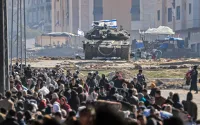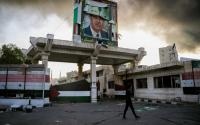19 March 2005Ann Scott Tyson
Two years after the United States launched a war in Iraq with a crushing display of power, a guerrilla conflict is grinding away at the resources of the U.S. military and casting uncertainty over the fitness of the all-volunteer force, according to senior military leaders, lawmakers and defense experts.
The unexpectedly heavy demands of sustained ground combat are depleting military manpower and gear faster than they can be fully replenished. Shortfalls in recruiting and backlogs in needed equipment are taking a toll, and growing numbers of units have been broken apart or taxed by repeated deployments, particularly in the Army National Guard and the Army Reserve.
"What keeps me awake at night is, what will this all-volunteer force look like in 2007?" Gen. Richard A. Cody, Army vice chief of staff, said at a Senate hearing this week.
The Iraq war has also led to a drop in the overall readiness of U.S. ground forces to handle threats at home and abroad, forcing the Pentagon to accept new risks -- even as military planners prepare for a global anti-terrorism campaign that administration officials say could last for a generation.
Stretched by Iraq and Afghanistan, the United States lacks a sufficiently robust ability to put large numbers of "boots on the ground" in case of a major emergency elsewhere, such as the Korean Peninsula, in the view of some Republican and Democratic lawmakers and some military leaders.
They are skeptical of the Pentagon's ability to substitute air and naval power, and they believe strongly that what the country needs is a bigger Army. "The U.S. military will respond if there are vital threats, but will it respond with as many forces as it needs, with equipment that is in excellent condition? The answer is no," said Sen. Jack Reed (D-R.I.).
To be sure, the military has also benefited from two years of war-zone rotations, and from a historical perspective it is holding up better than many analysts expected. U.S. troops are the most combat-hardened the nation has had for decades, and reenlistment levels have generally remained high. The war has also spurred technological innovation while providing momentum for a reorganization of a military that in many ways is still designed for the Cold War.
Moreover, military leaders are taking steps to ease stress on the troops by temporarily boosting ranks; rebalancing forces to add badly needed infantry, military police and civil affairs troops; and employing civilians where possible. Yesterday, defense officials worried about recruiting announced that they will raise the age limit, from 34 to 40, for enlistment in the Army Guard and Reserve. The Pentagon is spending billions to repair and replace battle-worn equipment and buy extra armor, radios, weapons and other gear.
Yet such remedies take time, and no one, including senior officials, can predict how long the all-volunteer force can sustain this accelerated wartime pace. Recruiting troubles, especially, threaten the force at its core. But with a return to the draft widely viewed as economically and politically untenable, senior military leaders say the nation's security depends on drumming up broader public support for service.
"If we don't get this thing right, the risk is off the scale," said Lt. Gen. Roger C. Schultz, director of the Army National Guard, the military's most stressed branch.
A Tough Sell
At dusk the night the Iraq war started in March 2003, Staff Sgt. Spurgeon M. Shelley was near the Kuwaiti border, watching the orange glow of missiles streak overhead as he guided one Marine ammunition convoy after another north across the line of departure.
Manning a dirt berm while wearing his gas mask and full chemical suit, Shelley was determined to make it home alive to see his daughter, Lena, 2. "I'm going to do whatever I have to, to survive," he told himself.
Today, Shelley is on duty in what he calls a "one-man fighting hole" on another battlefield -- a Marine recruiting station in Lexington Park, Md., in St. Mary's County -- with a mission to persuade young men and women to enlist, and probably go to war.
One recent night, after making dozens of fruitless phone calls to high school students, Shelley said his recruiting job is more taxing than combat. "I hear 'no' more times in one day than a child would hear in their entire childhood," he said. "If I had hair, I'd pull it out."
The active-duty Army and Marine Corps, and five of six reserve components of the military, all failed to meet at least some recruiting goals in the first quarter of fiscal 2005, according to Defense Department statistics. The active-duty shortfalls came amid rising concern among Army and Marine officials that their services risk missing annual recruiting quotas for the first time this decade.
Shelley, for example, has signed up four people in nearly six months, despite working 16-hour days. Asked why recruiting is so difficult, he has a quick reply: "The war."
Increasingly, surveys show that the main reason young American adults avoid military service is that they -- and to a greater degree their parents -- fear that enlisting could mean a war-zone deployment and death or injury. One survey showed such fears nearly doubling among respondents from 2000 to 2004.
Indeed, today's recruiting problems reflect a widespread concern dating from the conception of the all-volunteer force in 1973 -- that a military composed wholly of volunteers would not supply adequate troops for a lengthy ground war.
But confidence in the force has since grown as it gained discipline and professionalism. Meanwhile, overseas missions proliferated, even as the military downsized drastically. The Army shrank from 40 active-duty and National Guard divisions during the Vietnam War to 28 when the Cold War ended, and it has 18 now.
The military is seeking to rebuild forces, adding temporarily 30,000 Army soldiers and 5,000 Marines. But the war isn't the only obstacle. Rising college attendance and an expanding job market are giving high school graduates more choices. "It's times like this when unemployment is reaching 5 percent that is a critical level" for undercutting recruitment, said Curtis L. Gilroy, director of accession policy for the Defense Department.
To meet its targets, the Army is considering expanding the use of enlistment bonuses of as much as $20,000. Both the Army and the Marines are adding hundreds of recruiters, who "will have to work very, very hard," Gilroy said.
Shelley's situation exemplifies the pressure on today's recruiters. Up at 6:30, he consults his "plan of attack," a white sheet of paper on which he pencils in his activities by the hour. At lunchtime, he hits fast-food restaurants. When school lets out at 2:45, he starts calling potential recruits at home. In early evening, he goes to gas stations or the 7-Eleven, scouting for youths with "less desirable" jobs. At night, he is out "AC-ing," or "area canvassing," until 10:30.
Palming the steering wheel of his steel-gray Dodge Stratus one night, Shelley cruises slowly past a Chick-fil-A. Scanning the cars, he estimates who's in the restaurant and whether it's worth going in. It's not.
He makes one last, failed pitch of the day -- to an overweight young man stacking tomatoes at Giant -- and heads home. As long as the war drags on, recruiting won't improve, he predicts. "I think it's going to get worse."
Growing Demands
As the military struggles to find fresh recruits, there is unprecedented strain on service members and their families.
Since 2001, the U.S. military has deployed more than 1 million troops for the wars in Iraq and Afghanistan, with 341,000, or nearly a third, serving two or more overseas tours.
Today, an entrenched insurgency in Iraq ties down 150,000 U.S. troops, inflicting upwards of 1,500 deaths so far -- more than 10 times the number killed in the major combat operations that President Bush declared ended on May 1, 2003.
Because of the spreading violence from the insurgency, coupled with a smaller foreign coalition than was hoped for, the U.S. Army and Marines in particular have scrambled to keep a force of roughly 17 brigades in Iraq until now, rather than draw down to eight brigades or even be out altogether, according to previous military projections.
Lt. Gen. James J. Lovelace Jr., the Army's operations chief, is a kind of circus master responsible for juggling limited units and equipment and prioritizing who does what. Ringed by organizational charts in his Pentagon office, the West Point graduate from Richmond ticked off the far-flung corners from which the Army has had to muster forces.
"We've deployed units of the Old Guard!" he said, referring to the first-ever deployment of the ceremonial guard from Fort Myer, when a company was dispatched to Djibouti last year. "We've reached up inside of Alaska and grabbed the forces up there," he said. "Korea! Who would have ever thought that we would have deployed a combat formation?" he said, referring to a brigade sent from South Korea to Iraq.
Two years ago, the Army released 2,500 recruiters so they could ship out with tactical units, officials say. The Marines also sent scores fewer people to recruiting school because they were needed for military operations.
Reenlistment rates, which have remained strong despite lengthy combat tours, took a slight downturn in the active-duty Army and Army National Guard during the first four months of fiscal 2005. The Army met 94 percent of its target for getting first-term soldiers to reenlist, and it hit 96 percent among those in mid-career. An earlier study of troops in Bosnia showed they were initially more likely to reenlist than those who had stayed home, but their renewal rates dropped as the number, length and danger of deployments increased.
"I worry about the soldiers with the second and third tour . . . since 9/11," Cody, the Army vice chief, told reporters Thursday.
As it rounds up troops for deployments, the Army has had to allocate limited equipment. It has shuffled thousands of items from radios to rifles between units, geared up new industrial production, and depleted the Army's pre-positioned stocks of tanks, Humvees and other assets to outfit units for combat.
Army stocks in Southwest Asia are exhausted, and those in Europe have also been "picked over," one U.S. official said. Roughly half of the Army and Marine equipment stored afloat on ships has been used up, the official said. Refilling the stocks must wait until the Iraq war winds down, Army officials say.
Meanwhile, a sizable portion of Marine and Army gear is in Iraq, wearing out at up to six times the normal rate. Battle losses are mounting; the Army has lost 79 aircraft and scores of tanks and Bradley Fighting Vehicles. "We are equip-stretched, let there be no doubt about it. . . . This Army started this war not fully equipped," Cody said in recent congressional testimony.
The priority on allocating scarce resources to deployed units means that forces rotating back home -- especially reserve units -- are dropping in readiness. In many cases, they are being rated at the lowest level, C4, because of a lack of functioning equipment, required training or manpower.
"The Army in the aggregate is reporting readiness levels that are less today than they have been in the past," said Paul W. Mayberry, deputy to the undersecretary of defense for personnel and readiness.
The Pentagon says that by rotating duties, it maintains enough ready forces and pre-positioned equipment to handle a crisis on the Korean Peninsula and other contingencies. But U.S. lawmakers are concerned.
Sen. John W. Warner (R-Va.) said he worries primarily about the U.S. ability to respond if "some problem should arise on the Korean Peninsula."
"How capable are we of handling another major conflict?" asked Sen. John McCain (R-Ariz.). "It's pretty obvious that it would be incredibly difficult because of the portion of our resources devoted to Iraq and Afghanistan. What if a conflict broke out with North Korea or Iran?"
Feeling the Strain
Of all the military branches, the Army National Guard and the Army Reserve are suffering the most, as they provide between a third and half of the troops in Iraq, despite a legacy of chronic shortages in their manning and equipment.
"The real stress on the system was the fact that no one envisioned that we would have this level of commitment for the National Guard," which shipped seven combat brigades to Iraq and Afghanistan for the most recent rotation, Cody said.
Because the Army traditionally undersupplies Guard and reserve units, few had the troops or gear needed when mobilized. As a result, large numbers of soldiers and equipment were shifted from one unit to another, or "cross-leveled," to cobble together a force to deploy.
"We were woefully underequipped before the war started. That situation hasn't gotten any better. As a matter of fact, it gets a little bit worse every day, because we continue to cross-level," Lt. Gen. H. Steven Blum, chief of the National Guard Bureau, told Congress this month.
The widespread fracturing of units is making it increasingly difficult for the Army to assemble viable forces from the remaining hodgepodge -- most of which have low readiness ratings, Army figures show. "It's a little bit like Swiss cheese. We've taken out holes in the units," Lovelace said. "Those holes are a lot of times leaders, and they are hard to grow."
Already, the Guard and Reserve have deployed the vast majority of their forces most needed for fighting counterinsurgencies in Iraq and Afghanistan -- such as military intelligence, civil affairs, infantry and military police -- bringing into question whether the Pentagon's two-year limit on reserve mobilizations is sustainable.
"Can we do this forever? No. We can't do this forever at current levels," the Army National Guard's Schultz said in an interview.
In a sign of deeper problems, career citizen-soldiers frustrated by broken units and long, grueling war-zone duties are increasingly leaving the Guard. Attrition among career guardsmen is running at nearly 20 percent, said Schultz, who expects that as many as a third of the members of some units rotating back from Iraq will quit.
Recruitment is sluggish, reaching just 75 percent of the target for the first quarter of fiscal 2005 -- meaning that the Guard is unlikely to reach its desired strength of 350,000 soldiers this year.
The viability of the Army Guard and Reserve will prove decisive, senior Army leaders say, as they consider in 2006 whether to permanently increase the size of the active-duty Army, and if so by how much. It also marks a critical test of the military's ability to appeal to the civilian population, not only with bonuses and education benefits, but also with an ethos of self-sacrifice that it considers the bedrock of the all-volunteer force.
"For the all-volunteer force to work, it has to work all the time, not just in peacetime," Schultz said. "It's now time to answer the call to serve, to assemble on the village green."






